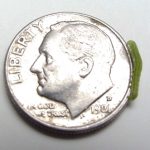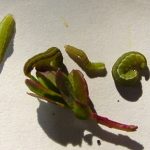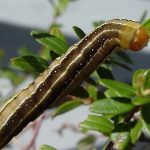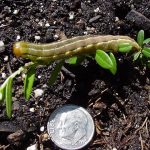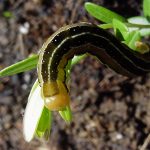False Armyworm
- False Armyworm Caterpillar (early instar)
- False Armyworm Caterpillars (early instars)
- False Armyworm Caterpillar (final instar)
- False Armyworm Caterpillar (final instar)
- False Armyworm Caterpillar (final instar)
- False Armyworm Caterpillar (note the four pairs of hind legs and the striping on the body)
Description: The false armyworm is a member of the cutworm group and its appetite is voracious! The young caterpillars will feed on new terminal buds, often before any new growth has started, although they will eat the new growth as well. They can be hard to identify when they are very young. Until they get bigger, they highly resemble spanworms because they will ‘loop’ somewhat while crawling the way that loopers (or spanworms) do. Unlike spanworms, however, false armyworms have three pairs of hind legs versus just 1 pair, and older larvae will have four pairs (you can see the legs clearly in the right-most photo above). Older, larger larvae–which can grow to two inches in length–will also have an obvious stripe running the length of each side of the body (the yellow portion of the striping is what tends to stand out the most, visually). Finally, false armyworms are usually some shade of green in color, especially lime green, but there is considerable variation in coloring (various shades of green, to dark brown, to black). False armyworm is univoltine, meaning it goes through just a single generation per year. It overwinters as a moth, and the females will lay about 600 eggs total, in masses of sometimes 100 or more, in late April and very early May. They are deposited on the cranberry stems or on the undersides of the leaves, and hatching of the eggs for much of Maine takes place, on average, starting generally (most years) in late May.
Sweepnet-Captured ‘First Dates’: 6/6/97, 5/28/98, 5/28/99*, 5/24/00, 5/31/01, 5/13/02*, 5/24/05, 5/25/07, 5/14/08, 5/14/09, 5/16/2013*♦, 5/20/2014*♦ (Average of these = May 23rd)
Dates are when active insects were found for the first time during each indicated year on any commercial Maine cranberry bed.
* = 1st day scouting that year
♦ = central Maine; larvae were newly-hatched
Control: For specific and current control recommendations for Maine, please refer to the Maine Cranberry Pest Management Guide. Don’t forget that a Late-Water (LW) flood controls false armyworm very well: Late-water Flood Management (pdf) | Late-water Flood Management (MS Word)

